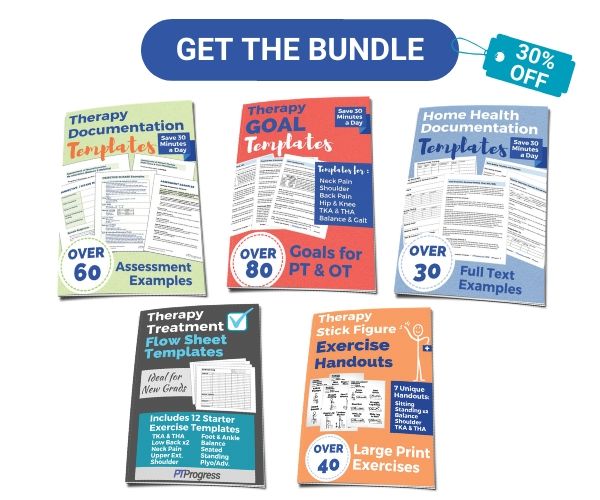


The physical therapy assessment portion of a therapy note is the why behind the treatment you provided during your patient’s visit.
A great therapy assessment accomplishes two things:
In addition, your therapy assessment documentation should include a summary of the patient’s ability (or difficulty) in performing a specific task. Relating the treatment back to a functional goal will round out an excellent assessment.
You’ll find yourself writing a lot of assessments throughout your career. Most commonly, you’ll include an assessment when completing daily notes, documenting progress notes, or writing an evaluation. But no matter the occasion, the assessment component can become the most time-consuming portion of your documentation. Learning how to write efficient, effective notes early on will save you precious time.
To start, let’s look at some example therapy assessments.
A physical therapy evaluation assessment succinctly summarizes your findings and answers the question: “Why does this person need PT?”
Try following this simple outline for an evaluation assessment:
Evaluation Assessment Example:
Patient presents with signs and symptoms consistent with diagnosis of R Hip OA, s/p 1 week post operative R THA. Rehab potential is excellent. Key impairments include: decreased ROM and strength of the left lower extremity, poor balance and compensatory gait patterning, increased swelling, and pain with functional activities such as squatting, walking, and climbing stairs. Skilled PT is required to address these key impairments and to provide and progress with an appropriate home exercise program. This evaluation is of moderate complexity due to the changing nature of the patient’s presentation as well as the comorbidities and medical factors included in this evaluation.

Interested in the full sample evaluation? Documentation templates and evaluation examples are included in the Efficient Documentation course.
You don’t need to write a paragraph for this type of documentation, but being too brief could diminish important aspects of your skilled assessment. Focus on the key elements you worked on in the session. If you targeted balance training, your assessment should reflect why.
It wouldn’t make sense to spend the majority of your treatment on balance and stability training but then spend the majority of your assessment writing about soft tissue restrictions. Your assessment should reflect your treatment both truthfully and proportionally.
Here are two examples of a brief daily note assessment:
This assessment statement identifies the purpose of your treatment as well as the patient’s response to your treatment. Additionally, it incorporates the functional goals you’re working towards.
This brief assessment phrase targets a key impairment that could lead to further injury if left unaddressed. Phrases like this will clue the reader into your intentions and help your writing reflect the skilled treatment you provided.
See three tips below for how to write better documentation in less time.

Stating the patient’s improvement in strength, balance, or mobility is a good use of the assessment. It’s also helpful to acknowledge areas that need continued work. Here’s an example:
We’ve all seen this lazily-written phrase before: “The patient tolerated treatment well.” Seeing only this in the assessment section should make you cringe.
Rather, the report should include observations of the patient’s response, such as an ability to change movement patterns or posture, physical changes or adaptations during treatment, degrees of stability, etc. Here’s an example:
Lastly, the assessment gives you an opportunity to advocate for continued care. By acknowledging current improvements, identifying remaining impairments, and stating your reason for addressing these impairments, you will make a strong case for continued therapy.

Tim Fraticelli, DPT Physical Therapist
Tim Fraticelli is a Physical Therapist, Certified Financial Planner™ and founder of PTProgress.com. He loves to teach PTs and OTs ways to save time and money in and out of the clinic, especially when it comes to documentation or continuing education. Follow him on YouTube for weekly videos on ways to improve your financial health.



Disclosure: This post may contain affiliate links, meaning I may get a commission if you decide to make a purchase through my links, at no cost to you. Please read my disclosure for more info.

PTProgress brings physical therapy education to you with career insights, education resources, and health content to help you make progress toward your goals.
In addition to helpful documentation templates and continuing education discounts, you can find free articles and physical therapy videos on the blog and YouTube channel.
Tim Fraticelli, DPT, CFP®
Physical Therapist
Founder, PTProgress.com